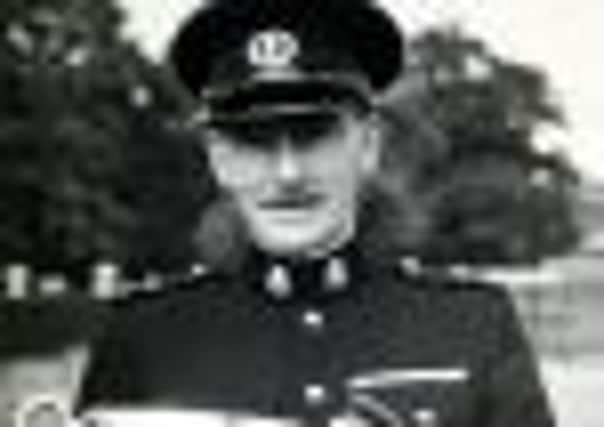Major John Rae


Born in Glasgow on January 28, 1928, his early childhood was spent in London, Ontario. His family had migrated to Canada when he was a baby.
Hit hard by the Wall Street Collapse and the Great Depression, they returned to Scotland in 1933, settling in Edinburgh.
Advertisement
Hide AdAdvertisement
Hide AdThere he absorbed the literary romanticism of Sir Walter Scott, and lapped up the swashbuckling tales of Alexandre Dumas. With a group of like-minded teenagers he formed a group of ‘musketeers’ and became an accomplished fencer.
Then, in 1944, aged 17, the romance of bearing arms matured into reality; sword was exchanged for rifle. He enlisted in the Royal Scots, the senior regiment of the British Army. After a few weeks of training he was on a troop ship bound for Burma.
He remained in the Far East from 1944 to 1947, first engaging with the Japanese enemy in Burma and Malaya, and then serving with the post-war garrison of Singapore. From there, he went to India for the transition to Indian independence and partition.
After being de-mobilised in 1947, he tried a variety of jobs, but he found it difficult to adjust to civilian life. So he re-joined the Army to take a commission. He was halfway through his officer training at Eaton Hall in Cheshire when the Korean War suddenly flared up. Rather than miss the action, he volunteered for active service with the Gloucestershire Regiment.
Advertisement
Hide AdAdvertisement
Hide AdAfter a few days of leave in early 1951, to marry Mary Bodman and share the briefest of honeymoons, he was on a troop ship bound for Korea.
The heroic stand of the ‘Glorious Glosters’ at the Battle of the Imjin River (22-25 April 1951) witnessed the largest loss of life by any British military force between 1945 and the present day. He survived the battle by being left for dead on the field.
He had not been shot, but suffered a burst appendix causing him to collapse. He was rescued by an American helicopter and airlifted to a Norwegian MASH unit. Meanwhile, he was listed as “missing, presumed killed in action” and his wife, Mary, received ‘the’ telegram. Back from Korea he marched with the surviving Glosters to receive the freedom of the City of Gloucester.
On completing his officer training, he was commissioned as a full Lieutenant into the South Lancashire Regiment, being promoted to Captain when the regiment was stationed at Catterick.
Advertisement
Hide AdAdvertisement
Hide AdThis marked his move to Yorkshire, where he would remain for the rest of his life.
Peacetime duties he found dull, but he compensated by developing his shooting skills as one of the champion marksmen of the British Army, winning numerous awards and tournaments, both individually and leading a team. He was champion of all three services for three years in succession, receiving the Hartley Challenge Cup from Field Marshal, Viscount Montgomery of Alamein.
His most astonishing shooting feat was when he won the Palatine Jewel by achieving a perfect score despite thick fog obscuring the targets. As the fog rolled in he had taken various visual markers that enabled him to aim for and ‘see’ the unseen target. His stunning success saw him ‘chaired’ around the field.
He could see that the peacetime army would soon be greatly downsized and transformed. So he left the regular army in 1958, moved from Richmond to settle in Ilkley, and went into business. He chose that most Scottish of commercial fields - insurance.
Advertisement
Hide AdAdvertisement
Hide AdAfter a brief spell with the Scottish Amicable, he established in the centre of Leeds his own insurance broking firm: John Rae and Company, represented at Lloyds.
Over a period of 40 years, this was to become one of the most respected insurance broking firms in the North of England, servicing major clients from all parts of the country.
In parallel with his business career he was drawn - through the activities of his three children - into forms of honorary support for the arts.
The eldest, Elizabeth, became a ballet dancer, training at the Royal Ballet School. This led to him being instrumental in establishing the Yorkshire Ballet Seminars, which discovered and developed talents such as the Yorkshire-born dancer and choreographer, David Bintley, now director of the Birmingham Royal Ballet.
Advertisement
Hide AdAdvertisement
Hide AdHis son Charles, composer and conductor, studied the piano with Dame Fanny Waterman, as did the youngest, Caroline. This led to a long involvement with the Leeds International Piano Competition; he served as a member of the Executive Committee of the LIPC from the late 1970s until his death.
His other passion was the preservation of an architectural jewel in the centre of Leeds: The Leeds Club, in Albion Place. He was to serve as Chairman for 15 years, from 1983 to his retirement in 1998. He rescued the club from a precarious financial position, transformed the membership by admitting ladies as full members of this ‘gentlemen’s’ club, and - with the aesthetic guidance of his wife, Mary - renovated the interiors of the elegant, 19th-century building, restoring them to their former glory.
John Rae leaves his wife, three children, and six grandchildren. After cremation at Lawnswood in North Leeds, his ashes will be interred at the Rae/MacRae ancestral burial ground of Clachan Duich in Kintail, Scotland.